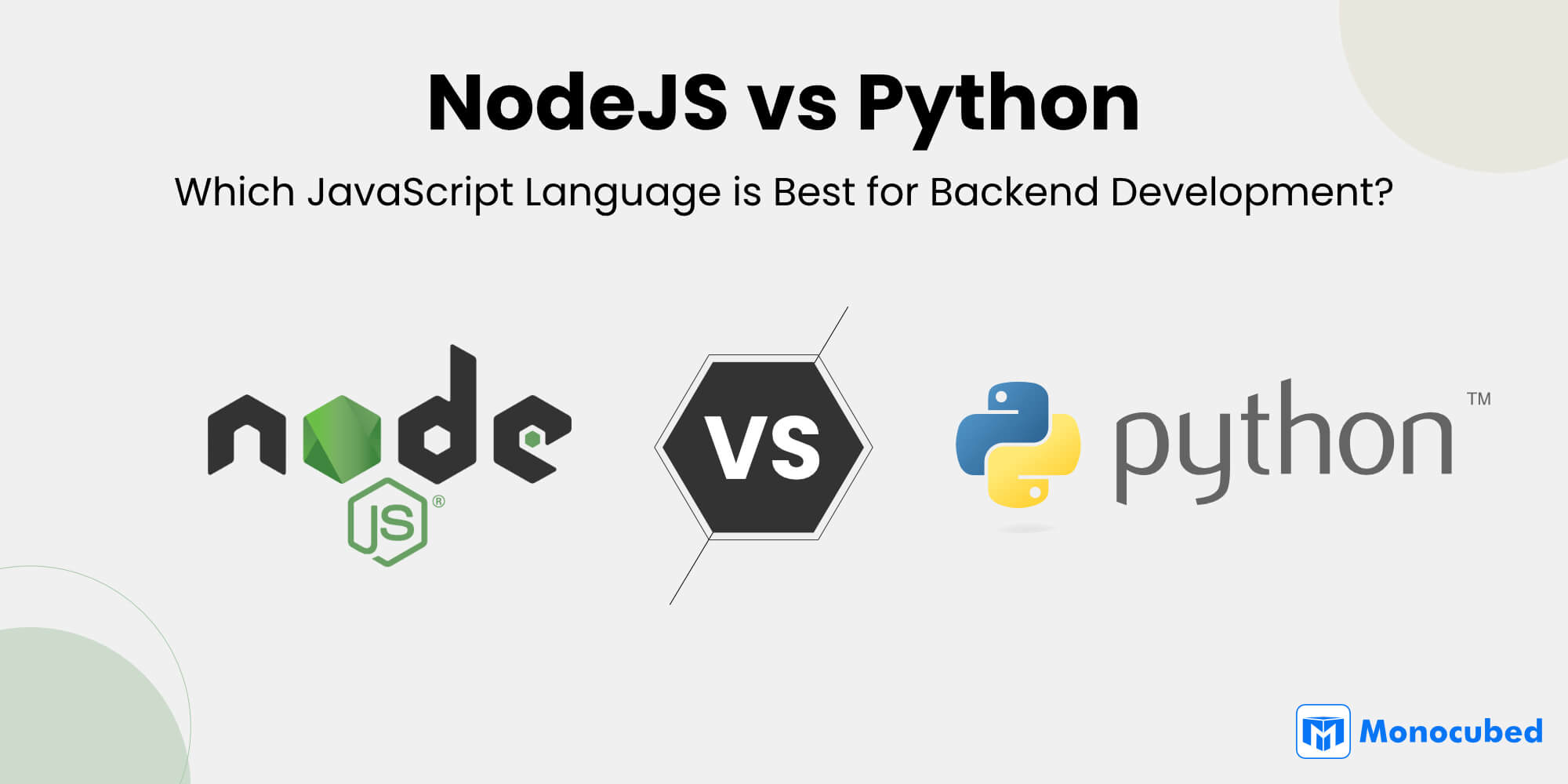Have you ever wondered which coding tool to pick when it comes to building the core of your website? It’s a common concern among developers, and it’s essential to get it right.
NodeJS and Python are two major players in the backend development arena, each with its own set of superpowers.
In this blog, we’re going to answer the following questions:
- What are NodeJS and Python?
- What are the advantages of both programming languages?
- Which one is the perfect match for your backend development needs?
Whether you’re a coding expert or just taking your first steps into the tech world, we’ve got you covered. And if you’re looking for expert guidance in making the right choice, consider consulting a custom web development service provider proficient in both Node.js and Python. . Consulting with such a firm can help you navigate the complexities of these technologies, and assess your project’s specific needs.
Let’s understand NodeJS vs. Python in detail and find the best fit for your project.
Table of Contents
Understanding NodeJS and Python for Web Development
Before we dive into the comparison, let’s first familiarize ourselves with NodeJS and Python.
What is NodeJS?
NodeJS is a powerful JavaScript runtime environment built on the Google Chrome JavaScript engine. It allows developers to run JavaScript code on the server side, making it particularly useful for creating scalable network applications and services.
Advantages of NodeJS Programming Language
- NodeJS excels in handling I/O processes, making it ideal for streaming large volumes of data, such as audio and video files, with minimal delay.
- NodeJS is excellent for rapid prototyping, allowing businesses to quickly develop and test new ideas and features, significantly reducing time-to-market.
- NodeJS enables a unified codebase for both the client and server side, simplifying the development process and reducing the likelihood of discrepancies between front-end and back-end code.
- The server-side rendering capabilities of NodeJS can enhance the SEO of web applications by ensuring faster page loads and improved rendering on search engine crawlers.
- With its lightweight and efficient processing capabilities, NodeJS is becoming increasingly popular for developing Internet of Things (IoT) applications.
What is Python?
Python is a high-level, interpreted programming language known for its simplicity and readability. It has achieved widespread adoption in various domains due to its versatility and ease of use.
Advantages of Python Programming Language
- Python’s advanced libraries like NLTK and SpaCy make it a leading choice for NLP tasks, enabling the development of applications with sophisticated language processing capabilities.
- Python is heavily used in scientific and numeric computing, with libraries like NumPy and SciPy providing tools for complex mathematical operations and data analysis.
- With libraries like TensorFlow and PyTorch, Python is at the forefront of machine learning and AI development, allowing for the creation of advanced predictive models and intelligent applications.
- Beyond web development, Python is also used for developing desktop GUI applications, with libraries like Tkinter and PyQt offering tools to create user-friendly interfaces.
- Python’s simplicity and readability make it a preferred language in educational settings, helping beginners grasp fundamental programming concepts and logic.
Want to Build a Web App Using Python?
Contact us. Our experienced developers are proficient at using Python to deliver scalable and powerful web app solutions.
Node.js vs Python: A Thorough Comparison of Both the Programming Languages
When it comes to backend development, the choice of the right backend technology between NodeJS and Python can significantly impact the efficiency, scalability, and success of your project. Let’s break down this comparison into key areas, using simple language, bullet points, and tables for an easy-to-understand and engaging overview.
-
Analyzing NodeJS and Python in Handling High-Traffic Environments
NodeJS
- Excels in handling asynchronous operations and multiple concurrent connections.
- Ideal for real-time applications like chat apps or live streaming services.
- Uses non-blocking I/O operations, enhancing performance and scalability.
Python
- Strong in CPU-bound tasks and synchronous processing.
- Better suited for applications with complex algorithms and data processing.
- Not as efficient as NodeJS in handling concurrent requests.
Check out the following table to get a better understanding of NodeJS and Python in handling high-traffic environments.
Aspects NodeJS Python Concurrency Thrives in environments demanding simultaneous processing, thanks to its event-driven architecture. Handles tasks sequentially, which can be a limitation in scenarios requiring high concurrency. Real-time Apps Its architecture is tailored for applications that need instant data updates and interactions. More suited to applications where immediate data processing is not a critical requirement. CPU-bound Tasks Better for lightweight computational tasks, with limitations in heavy computational scenarios. Superior in handling intensive computational tasks, often used in scientific and data analysis applications. Winner: NodeJS
Node.js excels in handling asynchronous operations and multiple concurrent connections, making it ideal for real-time applications. -
Comparing the Accessibility and User-Friendliness of NodeJS and Python for Developers
NodeJS
- Requires familiarity with JavaScript.
- Steeper learning curve for those new to JavaScript.
- Unified language for both frontend and backend can streamline development.
Python
- Known for its simplicity and readability.
- Ideal for beginners and those who prefer clear, concise code.
- Extensive documentation and community support make learning easier.
Check out the following table to get a better understanding of the accessibility and user-friendliness of NodeJS and Python for developers.
Aspects NodeJS Python Learning Curve Demands a good grasp of JavaScript and its asynchronous patterns, which can be challenging initially. Welcomes newcomers with its straightforward approach, making complex concepts more accessible. Syntax JavaScript’s syntax, while familiar to many, involves complex patterns like callbacks and promises. Emphasizes clean and readable Python code, which simplifies the development process. Beginner-Friendly More suitable for those with a background in JavaScript, as it extends its use to the server side. Often the first choice for beginners in programming due to its simplicity and wide range of applications. Winner: Python
Python’s simplicity, readability, and straightforward approach make it the winner in terms of developer accessibility and user-friendliness. -
Evaluating the Current Resources and Libraries Available to NodeJS and Python Developers
NodeJS
- Large, active community.
- Extensive range of packages available through NPM.
- Continuous updates and contributions from developers worldwide.
Python
- One of the largest programming communities.
- Rich set of libraries and frameworks for various applications.
- Strong presence in both web development and other fields like data science.
Check out the following table to get a better understanding of the current resources and libraries available to NodeJS and Python developers.
Aspects NodeJS Python Community Size Supported by a vast network of developers contributing to its rich library of modules. Enjoys a diverse and global community, contributing to its extensive range of applications. Libraries NPM offers a wide array of tools for various development needs, constantly growing with community contributions. PyPI serves as a comprehensive repository for Python, providing tools for a multitude of applications. Versatility While focused on web applications, it’s also making strides in areas like desktop and IoT applications. Its application extends from web development to playing a pivotal role in fields like AI and data science. Winner: NodeJS
NodeJS wins with its extensive range of packages available through NPM, offering a wide array of tools for various development needs. -
Assessing the Robustness and Safety Features of NodeJS and Python
NodeJS
- Robust security features, but requires additional security packages.
- Reliable for building scalable network applications.
Python
- Strong security, especially with frameworks like Django.
- Highly reliable for a variety of applications, including enterprise-level solutions.
Check out the following table to get a better understanding of the robustness and safety features of NodeJS and Python.
Aspects NodeJS Python Security Requires careful implementation of security practices and additional modules for robust protection. Offers a secure environment, especially with frameworks designed for secure web development. Reliability Known for its stability in handling numerous simultaneous connections in web applications. Trusted for its consistency and dependability in a wide range of applications, from scripting to complex systems. Winner: Python
Python is the winner for robustness and safety features, known for its strong security and reliability across different applications. -
Distinguishing the Ideal Application Scenarios for NodeJS and Python
NodeJS
- Ideal for I/O-bound applications, and real-time applications (e.g., chat apps, gaming).
- Suitable for single-page applications and APIs.
Python
- Great for data analysis, machine learning, and scientific computing.
- Preferred for large-scale enterprise applications and complex backend systems.
Check out the following table to get a better understanding of the use cases of NodeJS and Python.
Aspects NodeJS Use Cases Python Use Cases Real-time Apps Optimal for applications where immediate feedback and interaction are essential. Suitable for batch processing and tasks where real-time interaction is not a priority. Data Processing Ideal for applications that require efficient real-time data handling and processing. The go-to choice for applications that involve complex data analysis and computational tasks. Enterprise Apps Favoured for web applications that demand scalability and efficient real-time data handling. Preferred for large-scale applications requiring robust data processing and complex algorithmic functionality. Winner: Both
The choice depends on specific application requirements, Node.js (for real-time applications, single-page apps, and APIs), Python (for data analysis, machine learning, scientific computing, and large-scale enterprise applications).
Develop Web App Solution for Your Business
Contact us. We will analyze your web app idea and guide you from analyzing your project requirements to the deployment of your application.
Now that you have a better understanding of both the programming languages. If you still have any doubts about NodeJS and Python, then you can check out this FAQ section.
FAQs About Node.JS vs Python
-
Which are the popular frameworks for NodeJS and Python?
Here are the popular frameworks for NodeJS and Python.
For NodeJS
- Express.js: A minimal, flexible web application framework.
- Nest.js: A progressive framework for efficient server-side applications.
- Meteor.js: A full-stack JavaScript platform for mobile and web apps.
- Koa.js: A lightweight middleware framework for Node.js.
- Sails.js: A web framework following the MVC pattern for real-time apps.
For Python
- Django: A high-level, pragmatic web framework.
- Flask: A simple and easy-to-use micro web framework.
- Pyramid: A modular web framework for Python.
- Tornado: A framework and networking library for efficient connections.
- FastAPI: A modern, fast framework for building APIs with Python 3.6+.
-
How do I decide between NodeJS and Python for my specific project?
Here are the factors you need to consider to choose between NodeJS and Python for your project.
- Consider your project’s requirements. NodeJS for real-time tasks, Python for data analysis.
- Evaluate your team’s skills. NodeJS if they know JavaScript, Python if they’re experienced in it.
- Think about scalability needs. NodeJS for high traffic, Python for smaller projects.
- Check libraries and tools available for your project in both languages.
- Consider maintenance, support, and future growth when deciding.
Conclusion
In summary, both NodeJS and Python have their unique strengths and ideal use cases. NodeJS stands out in building efficient, scalable, and real-time applications, while Python excels in projects that require complex data processing, scientific computation, and versatility across different fields. Your choice should align with the specific needs of your project, the expertise of your development team, and the long-term goals of your application.
 By Yuvrajsinh Vaghela
By Yuvrajsinh Vaghela



